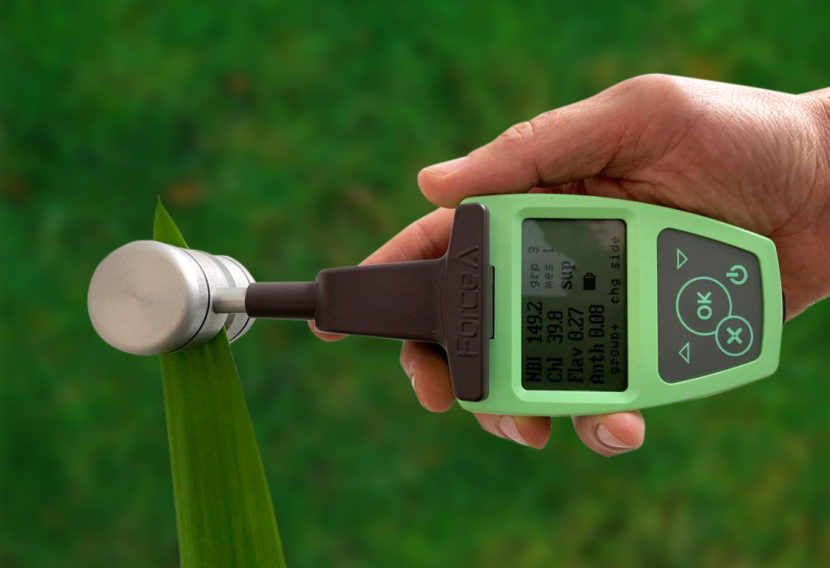品质至上,客户至上,您的满意就是我们的目标
技术文章
当前位置: 首页 > 技术文章
Dualex植物多酚-叶绿素仪:从高光谱图像和SIF反演估算辐射传输Vcmax来评估雨养和灌溉植物表型试验中的光合性能
发表时间:2022-04-28 13:19:38点击:1564
来源:北京博普特科技有限公司
分享:
Dualex是一款源自于法国国家科学院 (CNRS)及巴黎第十一大学技术,由奥地利PESSL公司生产(原法国Force-A公司)开发的新型多功能叶片测量仪。它可同时准确测量叶片的叶绿素含量、叶片表层的类黄酮和花青素含量,适用于植物生理学和农学(如水稻叶绿素浓度,玉米氮素状况,葡萄藤等)相关研究。
其测量对象可以是单子叶植物,双子叶植物或多年生植物。这款设备简单易用,可进a行实时和非破坏性测量。由于不需要校准标定和事先的样品制备,测量工作可在实验室或现场完成。此外,该设备在各种温度的和环境光照条件下均可进行简单、快速、无损测量叶片中的叶绿素、多酚以及花青素。

热点
在两种水分条件下,气载Vcmax作为一种光合特性进行了评估。
结合高光谱图像和范围反演的SIF估计Vcmax。
Vcmax与非水分限制条件下的净同化有密切联系。
水分胁迫下,Vcmax、NDVI、Cab和PSSRb与CO2同化密切相关。
摘要
植物的光合特性可能指示田间的耐逆性和表现,因此对其进行准确的评估在表型试验中至关重要。最大羧化速率(Vcmax)是估算CO2同化(a)的关键参数,因为它控制着CO2固定速率。这项研究表明,通过反演土壤冠层光合作用和能量观测(SCOPE)模型,结合基于机载的太阳诱导叶绿素荧光(SIF)和高光谱图像,利用精准农业技术中可用的传感器分辨率来估计Vcmax。在2015-2018年的生长季节,在三个小麦表型试验田中对Vcmax进行了量化,包括降雨和灌溉条件。使用两个高光谱传感器开展了测量,覆盖了400-850个区域 纳米(20 分辨率)和950–1750 纳米(70 厘米分辨率)光谱区域,并配有热摄像头(25 厘米分辨率)在8-14 μm区域。模型估计值和现场测量值之间的验证具有统计学意义(r2 = 0.77; p值≤2.2e−16),Vcmax与灌溉和降雨条件下的净同化有可靠的相关性(r2) = 分别为0.65和0.5。相比之下,模拟叶绿素含量(Cab)和空气中衍生的结构和叶绿素指标(NDVI和PSSRb)在灌溉地块中与同化率没有显著相关性,而在雨养地块中,同化率与作物水分胁迫指数(CWSI)之间的关系不显著。在灌溉条件下,遥感Vcmax的优越灵敏度可能与它对其他指数中观察到的高冠层密度畸变的鲁棒性有关。Vcmax的遥感检索以及本研究中展示的方法学与高通量植物表型分析和精准农业应用直接相关。

Radiative transfer Vcmax estimation from hyperspectral imagery and SIF retrievals to assess photosynthetic performance in rainfed and irrigated plant phenotyping trials
Highlights
Airborne Vcmax as a photosynthetic trait in two water regimes was assessed.
Vcmax was estimated combining SIF from hyperspectral images and SCOPE inversions.
Vcmax yielded a strong link with net assimilation in non-water limited conditions.
Under water stress, Vcmax, NDVI, Cab and PSSRb were well related to CO2 assimilation.
Abstract
Plant photosynthetic traits may be indicative of stress tolerance and performance in the field, making their accurate assessment critical in phenotyping trials. The maximum rate of carboxylation (Vcmax) is a key parameter for estimating CO2 assimilation (A), as it controls the CO2 fixation rate. This study demonstrates the utility of combining airborne-based solar-induced chlorophyll fluorescence (SIF) and hyperspectral imagery through the inversion of the Soil-Canopy Observation of Photosynthesis and Energy (SCOPE) model to estimate Vcmax, using sensor resolutions available in precision agriculture technologies. Vcmax was quantified in three wheat phenotyping experimental fields during the 2015–2018 growing seasons, comprising both rainfed and irrigated conditions. Airborne campaigns were carried out with two hyperspectral sensors, covering the 400–850 nm (20 cm resolution) and 950–1750 nm (70 cm resolution) spectral regions, and with a thermal camera (25 cm resolution) in the 8–14 μm region. Validation between model-estimated and field-measured Vcmax was statistically significant (r2 = 0.77; p-value ≤2.2e−16), and Vcmax was reliably associated with net assimilation both in irrigated and rainfed conditions (r2 = 0.65 and 0.5, respectively). By contrast, simulated chlorophyll content (Cab) and airborne-derived structural and chlorophyll indicators (NDVI and PSSRb) lacked significant correlations with assimilation rate in irrigated plots, while the relationship between assimilation rate and the crop water stress index (CWSI) was not significant in rainfed plots. The superior sensitivity of remotely-sensed Vcmax under irrigated conditions was likely related to its robustness to distortions from high canopy densities observed in other indices. The remote sensing retrieval of Vcmax, and the methodology demonstrated in this study is directly relevant for high-throughput plant phenotyping and for precision agriculture applications.